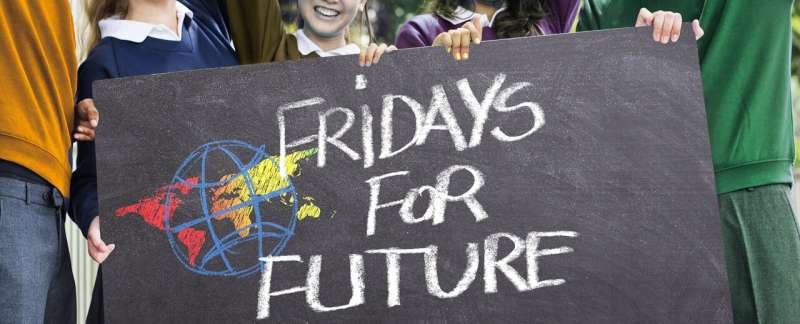This article has been reviewed according to Science X's editorial process and policies. Editors have highlighted the following attributes while ensuring the content's credibility:
fact-checked
trusted source
written by researcher(s)
proofread
As school students strike for climate once more, here's how the movement and its tactics have changed

On Friday, students will once again down textbooks and laptops and go on strike for climate action. Many will give their schools a Climate Doctor's Certificate signed by three leading climate academics.
These strikes—part of a National Climate Strike—mark five years since school students started walking out of schools to demand greater action on climate change. In 2018, the first students to strike defied calls by then prime minister Scott Morrison for "less activism" and to stay in school.
Last year, Australia voted out the Morrison government, in what was widely seen as a climate election. Teal independents won Liberal heartland seats on climate platforms, while the Greens recorded high votes. Labor came to office promising faster action on climate.
So why are school students still striking? Has the movement changed its focus? We have been researching these questions alongside young people involved in climate action in the ongoing Striking Voices project, as well as through the co-author's Sapna South Asian Climate Solidarity project.
We found the movement has expanded its demands from climate action to climate justice, stressing the uneven and unfair distribution of climate impacts. The movement itself has also become more diverse.
From climate action to climate justice
Across the world, young climate advocates such as those from School Strike 4 Climate are calling for "climate justice" alongside "climate action."
Why? Because climate change doesn't impact everyone equally. As the Australian Youth Climate Coalition puts it, it's "often the most marginalized in our societies who are hit first and worst by climate impacts and carry the burden of polluting industries."
Mere semantics? No. The idea of climate justice draws attention to existing social and ethical injustices which climate change amplifies. The phrase also points to the need for climate solutions that work for people in a transformative way and help create collective and just societies.
In Australia, calls for climate justice are intimately connected with justice for First Nations people and to protecting, defending and "heal[ing] Country," as Seed Mob write, with First Nations-led solutions.
Climate justice is central to the messaging of groups such as Pacific Climate Warriors diaspora, and Sapna South Asian Climate Solidarity.
In our conversations with young people, climate justice appears highly compelling. High-school student Yehansa Dahanayake explained: "I think I'd always thought of climate change as sort of a 2D thing. I thought about it as the temperature rise, deforestation, and sea caps melting—and while that is definitely true, I think [when] I started to learn about the justice aspects of climate change, [it] made me realize that there are many other factors that tie in, such as the Global North/ Global South difference and how that relates."
High-school student Emma Heyink told us about the importance of what she called a "justice-centered lens": "You can't look at climate change without looking at all these other issues. It just becomes so much more interlinked and solutions become so much more obvious."
Diversifying networks and strategies
So who are these young people, and what have they been doing in recent years?
Swedish student Greta Thunberg is frequently credited as sparking the youth-led climate movement.
But the movement is much larger—and more diverse—than one person, and increasingly so in recent years.
As a report by Sapna points out, Australia's youth-led climate justice networks are more likely to be racially diverse than mainstream climate movements.
Yet climate justice networks are not immune from the oppressive dynamics they protest against. When the co-author interviewed 12 now-graduated school strikers of South Asian heritage, they reported sometimes feeling sidelined in climate spaces—which are often white-dominated—as well as in media opportunities. As one young person put it, it seemed "hard to tell a brown person's climate justice story."
There are signs of positive change. The upheaval of the COVID pandemic saw stronger connections emerge between social movements, and clearer links between intersecting crises and injustices, both globally and in youth-led climate networks.
As recent high-school graduate and school strike organizer Owen Magee explained: "At our strikes, we are platforming First Nations people, rural and regional people who've directly been affected by the climate crisis, directly being affected by fossil fuel greed and corporation greed. That in itself is focusing on the intersectional nature of climate justice."
You can see this cross-pollination in the support shown by young advocates across multiple climate justice networks in the Power Up gathering on Gomeroi Country in northwestern New South Wales to show solidarity with Traditional Owners fighting coal and gas projects on their lands.
The targets and tactics of youth-led climate justice networks have shifted and proliferated in recent years—for example, to the banks that finance fossil fuel companies.
When school strikers graduate, some move into different modes of climate-related action.
Some have taken part in strategic climate litigation in a bid to create legislation embedding a climate duty of care for young people in government decisions on issues such as fracking approvals.
Others are involved in non-violent direct actions, such as next week's Rising Tide People's Blockade of the world's largest coal port in Newcastle.
Young climate advocates are battling for climate justice on a wide range of fronts. They are calling on politicians to do the same.
Provided by The Conversation
This article is republished from The Conversation under a Creative Commons license. Read the original article.![]()




















